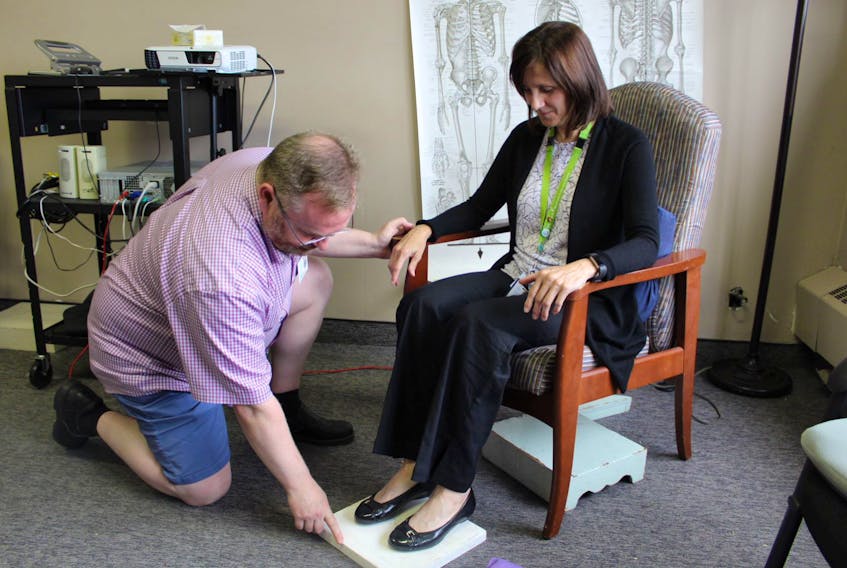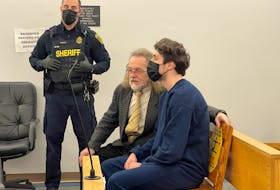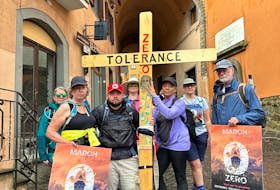ST. JOHN'S, N.L. — How bad is your pain?
That threshold is different for everyone. But how you manage that pain is the key to getting your life back on track.
The Centre for Pain Disability Management (CPDM) at the Miller Centre in St. John’s has been working on solutions to this plight since 1990 … and by the majority of accounts has been hugely successful.
“For the first time in eight years I have woken up many times over the last few weeks during the program with a major decrease in my pain levels,” said Lisa Codner-O’Flaherty, a former nurse and chronic pain sufferer.
Codner-O’Flaherty's chronic pain was caused by multiple surgeries, fusion with a rod and screws, and permanent nerve damage she suffered during her career.
“This has left me unable to feel parts of my leg and foot, and a whole host of other issues caused by back issues which contribute to my chronic pain,” she said.

Codner-O’Flaherty said she wants to help get the word out about the program so other people may avail of its services and gain their lives back.
The surgeries forced Codner-O’Flaherty to retire from nursing at age 44. She gave up all the activities and hobbies she loved doing and went from being active to being a body who wakes up and wonders how to get through a pain-filled day.
She recently completed a five-week program at The Miller Centre known as the Centre for Pain and Disability Management, an outpatient rehabilitation program for people with chronic pain or those who have been living with chronic pain for years and wish to learn how to become more active and lead fuller lives despite their pain.
The program began in 1990 for injured workers, and in 1994 expanded its mandate to include any person living with chronic pain. Included in the CPDM team are social workers, specialists in occupational therapy, recreational therapy, physiotherapy and psychology, a dietician, a nurse and a physician, who have knowledge in chronic pain.
The team’s approach offers expertise and varied resources that allow the individual to understand most chronic pain won’t be cured or resolved, but that there are strategies and tools available that will teach people how to understand and manage their pain and get some control back in their lives.
“It has restored my hope about the future and given back my control over my life. I cannot express how indebted I am to this organization and its staff for their patience, expertise and knowledge,’’ Codner-O’Flaherty said.
“My ultimate goal would be to see this program available out on the west coast or in central N.L.”
Costly care
Information found on the Canadian Pain Society's national website cited president Mary Lynch as saying treating chronic pain issues costs more than cancer, heart disease and HIV combined.
Estimates place direct health care costs at more than $6 billion per year, and productivity costs related to job loss and sick days at $37 billion per year.
It is estimated that one in four people will experience chronic pain in their lifetime, and it is a major contributor to other issues that include suicide, poverty and divorce.
But to ensure these issues are dealt with head on — or averted — the CPDM puts participants through the five-week program and teaches them to manage their pain.
Dean Penney, the clinical lead at the Centre for Pain Disability Management, aims to get people on the right track by employing what are called the “Nine P’s of Pain Management: Staying one step ahead of the pain.”
“Our goal is to teach people more efficient posture and body mechanics, relaxation, yoga and mindfulness,’’ Penney said.
“There are walking programs and aquatic programs we have developed so participants can be active without causing more pain,’’ he added.
Prior to starting the program, people are interviewed by CPDM staff in a thorough screening process to see if they are suitable or able to manoeuvre through the five-week program.
Each of the weeks has a structured process that teaches the participants what may be causing their pain to increase and how to work around it without causing more pain.
Everyone’s body mechanics are different, but all the principles are the same. Giving participants a format to follow is key and if they follow it properly, CPDM has been shown to have great success.
“People are encouraged to maintain the schedule we set up,’’ Penney said.
“Once they are discharged from the program, there will be a one-month follow-up, a three-month follow-up and individual follow-up as needed. These are lifelong conditions and it is important to discuss them,’’ he added.
Penney said education is the key to making this work, learning about the downward spiral that creates more issues with chronic pain, and the processes they use to reverse the spiral.
The Nine P’s
The following list of skills, referred to as the “Nine P’s,” can be beneficial in managing chronic pain:
Prioritize: Make what really matters count.
Plan: Delegate and time your activities.
Posture: Use least stressful positions when standing, walking and lying down.
Positioning: Maintain proper body mechanics while performing activities.
Pacing: Work in smaller activity bits. Work according to time schedule, not a pain level.
Power Breaks: Take breaks before your pain tells you to.
People Strategies: Talk up your pain management, not your pain.
Plan “B”: Recipe for flare-up days – take power breaks twice as often, cut activity in half, or adapt; and think positively.
Post-event analysis: Evaluate what worked well and what to try differently next time.









